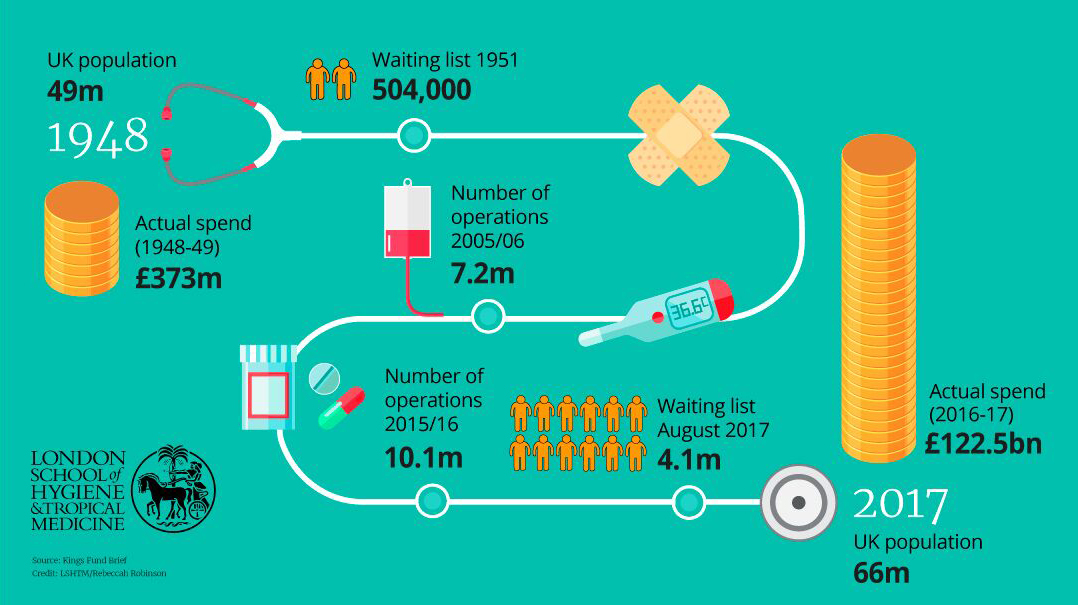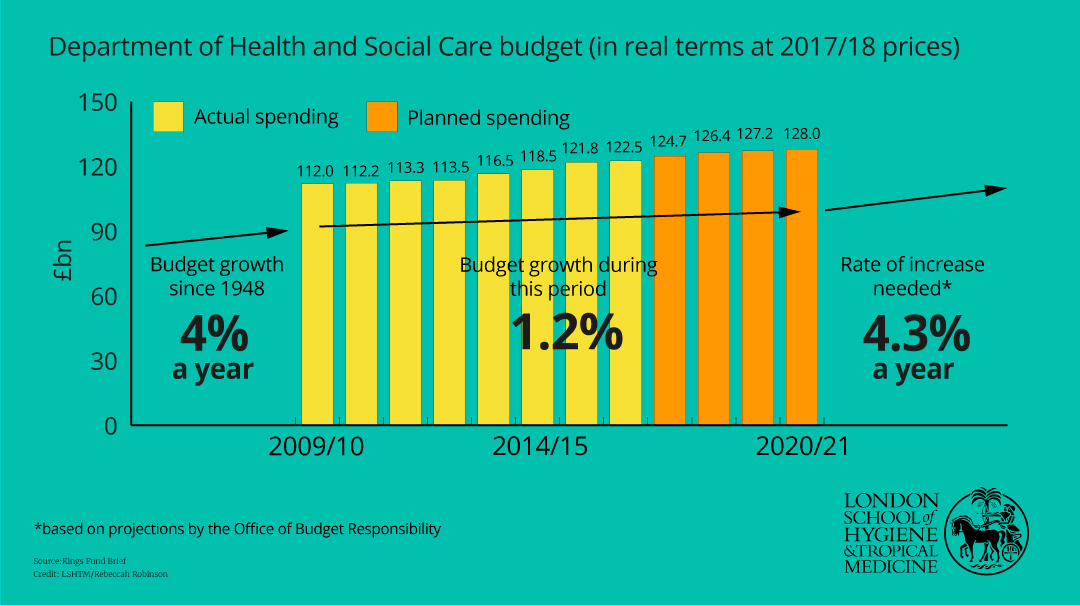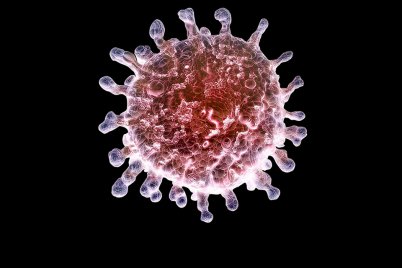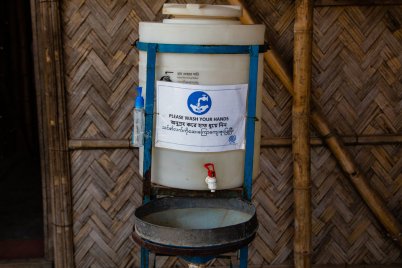
| This feature is part of our NHS at 70 series. |
|---|
Every morning, an hour before breakfast, Christina Crosbie takes six small tablets with a glass of water. And she thanks the National Health Service (NHS) for saving her life.
After standard chemotherapy treatment for the cancer Non-Hodgkin Lymphoma (NHL) finished in March 2013 at her local hospital in Leicester, she was devastated when the disease returned just seven months later.
Her consultant was keen for her to try the very latest medicine and suggested she join a clinical trial at Leicester Royal Infirmary. Christina was accepted on to the trial of new drug Tirabrutinib – which inhibits an enzyme which helps NHL grow -and after just three months was told she was free of cancer.
Four years on, she is still in remission.
“If it was not for the dedication and support of the staff I would not be here.”
Christina Crosbie
“The fact that I went on this clinical trial, within the NHS and run by its doctors, saved my life,” said Christina. “If it was not for the dedication and support of the staff I would not be here. I can now play with my grandson and go swimming – I just need to keep taking the tablets for the rest of my life.”
Christina has a lot to thank the NHS for. Since birth, she has benefited from treatment to mend a broken leg, having a hearing aid fitted during adolescence, surgery on her tonsils and spine, therapy to lower cholesterol as well as maternity services when she had her two children and, most recently, the successful cancer treatment.
Not only that, she has worked for the NHS for 30 years, starting with filing in the medical records department aged 17 and working her way up to becoming an administrator in the casualty department of Dumfries and Galloway Royal Infirmary in Scotland.
And this year, like the NHS, she celebrates her 70th birthday.
“I remember my mum saying I was one of the first babies born in the new maternity hospital, two months after the NHS began,” she said. “In the early days we all thought it was wonderful, that you could go to a hospital or GP and be seen for no charge.”.
Her first memory of the NHS was breaking her leg falling off a swing aged three and having it put in plaster at the Dumfries and Galloway Royal Infirmary in 1952. “What I remember most was the lift home in the ambulance,” she said.
Seventy years on, she’s seen a lot of changes – not all for the better. But at its heart she believes we are still very lucky to have it.
NHS then and now
Expert Collaboration
For 60 of those 70 years, the London School of Hygiene & Tropical Medicine has been publishing research on the NHS – from work to improve patient health outcomes to research which has helped shape and influence NHS policy and service delivery.
Its researchers have a unique insight into the birth of the institution which brought together, for the first time, hospitals, doctors, nurses, pharmacists, opticians and dentists under one umbrella organisation to provide services that are free for all at the point of delivery in 1948.
“We have close links to many parts of the NHS, from individual health care professionals on the front line to government officials. We have made important contributions at all levels.”
Pauline Allen, Professor of Health Services Organisation at LSHTM
Research has touched on every part of the NHS – from the importance of vaccination schedules, to cancer treatment outcomes, superbugs in hospitals, commissioning services and patient reported outcomes – many of which had a direct impact on patients like Christina.
For example, the work of the Eurocare project has been extremely influential in drawing attention to the poor cancer outcomes in the UK compared to other European countries.
The programme brought together EU cancer registries and showed that cancer survival in the UK was significantly lower than in many other EU countries. In 2015, research by Professor Michel Coleman into survival estimates informed the new national cancer strategy. Support for clinical trials like the one Christina was enrolled in was part of that plan.
The subsequent CONCORD programme – running at the School since 1999 - has now established surveillance of cancer survival trends in more than 70 countries world-wide, including 30 European countries.
The early days
The sacrifices made during the Second World War – when free medical treatment had been provided - led to the belief that Britain needed to become a fairer society. Access to medical treatment was an important part of this.
So as part of the new Welfare State, then-Health Secretary Aneurin Bevan promised healthcare free at the point of need, universally available to all.
Up to that point, about half of the population, working class wage earners, were covered by National Health Insurance. The rest - children, homemakers, older people and the middle class - were without cover. This meant they were charged by GPs and were means-tested for acute hospital treatment.
Local government public health services addressed infectious, psychiatric and chronic diseases, and those with no means had to rely on help under the Poor Law, but there was stigma attached to this..
On July 5, 1948, the NHS was launched.
In the post-war period, hospitals were still dominated by patients with infectious disease.
Paediatric wards were full of children with common infections, including many that are now preventable with vaccines, such as measles and polio. Adult medical wards echoed with the coughs of those with chest infections, many patients with lungs ravaged by a lifetime of smoking.
The 1950s saw a steady improvement in living conditions and a decline in infections. As people began to live longer, new health conditions emerged.
Christina was admitted to hospital in Dumfries for tonsil and adenoid removal as a young child in 1951 and remembers being fussed over by the nurses. Then, during a medical for secondary school entry, a hearing problem was picked up. This had a huge effect – with a hearing aid fitted at the local ENT department she went from being considered an under-performing child to one who did well.
“The teachers thought I was a stupid girl who did not pay attention,” she said. “But I was lip-reading to try and understand. I think I effectively lost a year of schooling as a result.”
She was able to go on and get the education she needed to gain her first position at the medical records department in 1966.
“We used to have fun. Because we were a smallish hospital – maybe 160-180 beds – the staff had lots of contact with each other,” she said. “I still remember Matron and the consultants serving up Christmas dinner for the staff during Christmas week.”
This is very different to her experiences of the NHS today, where she thinks there are too many managers. “I know there are more complex technologies and medicines now but I think it was better when there was a matron, treasurer and secretary and a sister in each ward. The NHS is top heavy and there’s not enough staff on the ground.”
Prof Allen agrees about the need for more clinical staff. She says we need to find a way of increasing the number of healthcare professionals working in the NHS, especially nurses.
“At the moment, we do not have enough staff to keep up with patient needs. So people end up waiting for care, and the staff are overworked and stressed. The quality of care suffers.”
How does the NHS compare?
Commissioning to improve patient care
Prof Allen specialises in research into commissioning health services and is co-director of PRUComm (Policy Research Unit on Commissioning) based at LSHTM which was set up in 2011 to provide evidence to the Department of Health to inform the development of policy on commissioning. She and her collaborators in Manchester and Kent have been researching commissioning - the process by which health and care services are planned, purchased and monitored - for the last two decades.
Commissioning is a complex activity but in its simplest form, she says it’s all about strategic planning - analysing how services are organised to understand the best way for parts of the complicated NHS system to work together in order to provide high quality care for patients. Many patients, especially older people and others with long term conditions, such as diabetes, need to be cared for by a range of people, such as GPs, community nurses, hospital doctors. “We need to understand how best to coordinate these services.”
Recently, their work has had a direct effect on policies to increase the number of GPs working in the NHS. They looked at GPs’ current concerns and advised on policies which might help encourage them to continue working as GPs, despite increasingly difficult working conditions. The ninth annual national survey of GPs published recently found 39% indicated that there was a considerable or high likelihood that they would quit within five years – up from 35% in 2015.
Her work on internal competition in the NHS between hospitals has demonstrated how limited its use in the NHS is, and how the regulatory framework on competition needs to be made clear as it is frequently misunderstood. She says: “Commissioners are more likely to use cooperative approaches to plan and change health services, and this makes sense when one understands the underlying economics.”
Golden age of the hospital?
The 1960s and 1970s are considered by some as the golden era of the hospital according to Dr Martin McKee, Professor of European Public Health at LSHTM, a time when there were major technological advances in open heart surgery, new operations for peptic ulcers, the first hip replacement in 1962, the first safe treatments for high blood pressure (diuretics and beta blockers) and major improvements in anaesthetics.
At the same time, staff felt respected and looked after, there was accommodation, food and a parking space provided. Hours were long but doctors were part of a consultant’s firm, or team. Prof McKee, who was a junior doctor in Belfast in the early 1980s, says that now hours are shorter but there’s more fragmentation, and doctors do not feel as valued, as evidenced in the strike of 2016.
Others see healthcare in those years as somewhat trial and error.
Sir Nick Black, Professor of Health Services Research at LSHTM, remembers starting as a junior doctor in 1974 in Birmingham. His memories of those days were of staff who were committed, compassionate and caring but technology was limited.
“In hindsight, there was a complete lack of monitoring of what effect the hospital, or the care, was having,” he says. “You had no idea how good it was or not.
“There was no evidence to tell us the best way to treat people. There was a lack of standardisation of equipment. That hospital had no idea whether its survival rate of neonates was good, bad, or indifferent. Looking back, it was amateurish compared to today.”
The biggest change in the modern NHS, he says, is its ‘scientisation’ with research evidence, clinical guidance, the introduction of the National Institute for Health and Care Excellence (NICE) which provides guidance on treatments and decides on the cost effectiveness of medicines, and monitoring and awareness of the outcomes of care, assisted by a flow of advances in pharmaceuticals, technology, diagnostic equipment, monitoring equipment. “Medicine has shifted from what was largely an art to what is now a mix of art and science.”
But the downside of that is too much focus on longevity and survival at all costs. “I think we’ve lost sight, to some extent, that the aim of medicine is not just to increase the length of people’s lives. It’s almost as if death is seen as a failure of medicine. Death is not necessarily a bad outcome.”
The challenge now, he says, is how do we get that balance back without appearing, and without being, callous and uncaring.
NHS budget and spending over time
New life – with all that entails
Aged 19, Christina suffered a bad fall in a hockey match and was in traction in hospital followed by an operation then rehabilitation in a convalescence home. After recovering, Christina married and at 28 started a family, having a son in 1976 and a daughter in 1979. Both had the benefits of primary care services for childhood illnesses and vaccinations, and avoided diseases such as measles.
One of the most controversial health issues in the late 1990s and 2000s was over MMR, the triple vaccination which was introduced in 1988 in the UK. Controversy arose when a flawed research paper linking it to colitis and autism led to a fall in uptake of the vaccine, sufficient to lead to an increase in cases of measles.
This led Dr Liam Smeeth, Professor of Clinical Epidemiology at LSHTM, and a part-time GP in north London, to investigate further, carrying out a study using the UK General Practice Research Database.
Data on 1,294 cases of people born in 1973 or later who had first recorded diagnosis of pervasive developmental disorder registered with a GP surgery between 1987 and 2001 were compared with 4,469 controls.
The authors found no association between having the MMR and an increased risk of autism or other pervasive developmental disorders. The study was widely credited with helping restore public faith in the MMR vaccine, and vaccine uptake increased back to the levels needed to prevent measles outbreaks – showing a real practical impact of LSHTM research on the nation’s health.
“This was an early pioneering use of electronic health records, and a project that convinced me of their potential,” he said.
In another study involving analysis of electronic data, his work demonstrated that large numbers of people who were at high cardiovascular risk had stopped their statin therapy after intensive media coverage. Twelve million people in the UK currently meet the criteria for taking statins – including Christina, who was prescribed the cholesterol lowering drugs at 60 by her GP.
The subsequent media coverage allowed the researchers to re-frame the debate on statins, acknowledging uncertainty about muscle symptoms, while explaining the evidence base of effectiveness.
One of the benefits of having a centralised health system is the enormous amount of data available for researchers to use. Prof Smeeth also utilised this this with a population-based cohort study of the impact of high body mass index on the risk of 22 different types of cancer, using data on 5.2 million UK adults.
“Using NHS data we were able to undertake the largest single study on this important question globally,” he said. “The enormous power allowed us to clearly delineate different relationships between body mass index and cancer risk at different body sites.”
BMI was linked to 17 of the 22 commonest cancers, and the researchers estimated that an average 1 unit increase in BMI would result in around 4,000 additional people developing cancer in the UK per year. Given that levels of overweight and obesity continue to rise worldwide – in both richer and poorer countries – these findings emphasize the need for measures to curb weight gain.
Surgery and superbugs
In the next decade the issue of hospital acquired infections came to the fore. Superbugs such as Methicillin-resistant Staphylococcus aureus (MRSA) and Clostridium difficile (C.diff) dominated the headlines, and staff tried to limit cross infection by increased use of single rooms and barrier nursing.
Clinical academic Sharon Peacock, Professor of Clinical Microbiology at LSHTM, is working to find ways to reduce infections that occur as a result of hospital outbreaks.
Detecting outbreaks and bringing them to a rapid close remains as important as ever across the NHS. Hospital infection control officers still rely on methods to do this that were first described in the 1880s by John Snow. A public health physician and one of the founders of modern epidemiology, he showed that the cause of cholera was water-borne by tracking an outbreak to a water pump in Soho in 1854.
Detection and control methods are based on surveillance for patients who become positive for particular organisms such as MRSA, and gram-negative bacteria that have become resistant to the carbapenem drugs, which is reserved for patients with the most serious infections. This is followed by epidemiological investigation to determine if cases are linked in time and place. Detecting outbreaks as soon as possible is essential to limit their spread, but this current approach can be slow – Prof Peacock and her team are devising new approaches that create an early-warning system.
This starts with routinely and prospectively sequencing all of the bacteria grown in the routine microbiology laboratory that can cause outbreaks and comparing their genomes, a ‘sequence first’ approach. They are able to sequence and analyse up to 20 bacterial genomes every day at their base in Addenbrooke’s Hospital in Cambridge.
Prof Peacock says: “If bacteria are very highly related, we assume that they are likely to be from the same transmission cluster. Redesigning the paradigm for outbreak detection using bacterial sequencing as the lead technology means that linked cases can be detected as soon as possible.”
This also allows rational use of infection control team time by excluding outbreaks that do not need further investigation, even when patients appear to be linked in time and place. The next step is a prospective evaluation to demonstrate whether this is cost-effective. “The work will have a positive impact on the NHS as it could bring outbreaks to a close more rapidly.”
Prof Peacock has worked in the NHS since she was 19 – first as a nurse, then retraining as a doctor, when she practised in a range of medical specialities before becoming a clinical microbiologist.
When asked what has changed in the NHS throughout her career, she immediately refers to a striking increase in the range of treatments and use of technology. “There are many examples of the introduction of technology that extends lives and improves quality of life, but one example is in cardiology. When I first became a doctor, there were limited treatments for people with serious cardiovascular disease. Now, there are numerous tests, drugs and interventions without full surgery that allow doctors to detect and treat conditions such as heart attacks as early as possible.”
She adds that comparable advances have occurred across the disciplines, including in cancer and transplantation, which makes her see the NHS today as in a golden age of technology.
“There’s been an incredible explosion of medical discoveries and innovations that bring benefit to patients.”
Sharon Peacock, Professor of Clinical Microbiology at LSHTM
Involving the patient
Another great development since 1948 has been the increased role of patients in their own care, whether that is in decisions on treatment or other aspects of care. She says: “There’s an increasingly strong partnership between healthcare staff and their patients. People have access to a wide range of medical information from the internet, and are often very well informed about their condition. This has been an important change since the NHS first came into being, and will continue to develop by giving patients access to their own medical records, such as is happening now at Addenbrooke’s Hospital with MyChart.”
Christina confirms when she was first treated in the NHS, the patient was not seen as a collaborator in their healthcare. But it was very different in her recent cancer treatment, when doctors and nurses asked for her opinions and feedback.
Prof Sir Nick Black is a leading figure in the field of taking account of patients’ views on care. He has pioneered work on Patient Reported Outcome Measures (PROM), which are now used throughout the NHS for certain high-volume operations.
He began his work on this in the 1980s, when patients’ views on the outcomes of their care were not considered, and it was in the doctors’ own interests to suggest that treatment had worked. He initially looked at treatment for benign prostate disease in men and stress incontinence and hysterectomy in women and gave patients questionnaires to fill in up to a year after treatment, then compared the answers with the doctors’ reported outcomes.
In the 1990s his research developed into working out how these questionnaires might be used routinely in the NHS alongside measurements around mortality and morbidity. By 2008 the Department of Health was testing the system until a national programme launched in 2009 so data was collected from everybody having a hip replacement, a knee replacement, or hernia surgery.
The impact of PROMS has been seen through showing up variations in care, for example a two-fold difference in the reporting of complications following operations by patients in different hospitals.
Sir Nick says LSHTM could certainly make a claim to have been a major player in the development of this pathway.
LSHTM was also involved in setting up the National Audit on Adult Intensive Care, followed by the Royal College of Surgeons in the 1990s jointly running various audits of different surgeries. More recently LSHTM researchers have worked with the Royal College of Obstetricians and Gynaecologists on its audits.
“The clinicians bring clinical support, ownership and enthusiasm, which is absolutely vital, but we bring the scientific skills and know-how to ensure the audits are robust.”
Sir Nick Black, Professor of Health Services Research at LSHTM
The impact of clinical audits - or league tables of departments and doctors/surgeons - is seen as an impetus to quality improvement. When certain units see they are not performing as well as others in ‘league tables’ there is a strong incentive to improve.
Under pressure
The NHS is undoubtedly suffering from pressures of increased demand and complexity of treatment required for an ageing population. Christina is pleased at the Government’s promised £20 billion boost over five years to 2023 but wishes the NHS could have even more funding, particularly for better pay for staff. “If it wasn’t for the doctors and nurses looking after you, then you would be ill and you wouldn’t be able to work and pay taxes and the government would end up with nothing,” she says.
“The dedication of the staff is wonderful and they deserve more than they are getting.”
One recent report revealed how emergency admissions are up 10%, ambulance calls are up 15% and diagnostic tests up 19%. Yet the workforce has only grown by 6% since 2014. In another survey of NHS staff, 59% are, on average, working additional unpaid hours each week.
Last month NHS staff (nurses, midwives, healthcare assistants, ambulance staff and others but excluding doctors and dentists) were given a rise of 6.5% over three years – eight years since the last meaningful rise.
Prof McKee says it’s a myth that underfunding of the NHS is a new thing – instead it has been under-resourced right from the beginning, although with an increase during the Blair/Brown governments when his research found an ‘appreciable’ acceleration in improvements in deaths from conditions amenable to health care.
“There was a backlog of unmet need in 1948 that had not been recognised – policy makers assumed they would be able to catch up the backlog and then after that, the routine stuff will be fine. But actually there was a huge backlog of unmet need that never really caught up.
“And it’s been under-resourced, all the way through - we’ve always been less resourced than other countries.”
Sir Nick agrees. “People have a rose-tinted view of the past. The NHS has always been under pressure. Every health care system is under pressure. It’s not unique to the NHS.”
And he adds that the same questions that are being asked on this anniversary were asked every decade the NHS has been celebrated. “There were the same accolades. Isn’t it wonderful but will it survive another decade? So all the things we’re hearing for the 70th birthday, that we heard at the 60th, the 50th, the 40th…but we’re still here.”
Not so different to the rest
The NHS is seen as very different to other health systems around the world, being free at the point of delivery and tax-funded. But researchers say it is not the only tax-funded system.
Prof McKee has been studying what the NHS can learn from other countries through his work with the European Observatory on Health Systems and Policies, a partnership of universities, including LSHTM, governments, and international agencies.
He says the Scandinavian countries as well as Spain, Italy, and Portugal are all tax-funded, and much of Canada’s is too. France and Germany have systems predominantly funded by social insurance, but still use a large element of tax funding for people who can’t pay. He notes that the US is the ‘outlier’ when it comes to health systems, where people regularly go bankrupt because they cannot afford to pay healthcare bills through lack of adequate or no employer or private health insurance.
The King’s Fund, a charity working to improve health and care in England, has analysed all the funding systems and says there’s no evidence that one funding model or particular mix of funding mechanisms is inherently superior to others. It quotes the Organisation for Economic Co-operation and Development (OECD) saying that this lack of evidence, plus the high costs associated with any transition, means that developed countries rarely make major changes to their primary way of paying for health care.
Policy analysts at the King’s Fund have written a series of papers with others to mark the 70th anniversary called How Good Is The NHS? It finds that the NHS performs neither as well as its supporters sometimes claim nor as badly as its critics often allege. “Compared with health systems in similar countries, it has some significant strengths but also some notable weaknesses.”
It adds that the NHS is a system set up to deliver the best care to everybody in the UK, and its staff believe deeply in this mission. “The most fitting birthday present the service could receive would be a national discussion about how government, society and the public can work with it to realise this goal more successfully than ever.”
We hope you enjoyed reading about our work in this feature. If you are interested in supporting projects like these and the many others we are leading to improve health worldwide, we would be delighted to hear from you. There are many ways you can make a gift to the School, from wherever you are in the world. Each and every gift we receive makes an impact, from funding scholarships, to updating our facilities or investing in new avenues of research. Whether it’s a gift of £5 or £500,000 your generosity will support our mission to improve health in the UK and around the world.








